Kilauea eruption shakes Volcano village residents

BRUCE ASATO / BASATO@STARADVERTISER.COM
Raysha Mae-Adrian, a lifelong resident of Volcano village, Hawaii, looked after her 3-year-old daughter, Robyn Adrian, Thursday at a community center playground at the Cooper Center, which is minutes away from Hawai’i Volcanoes National Park.
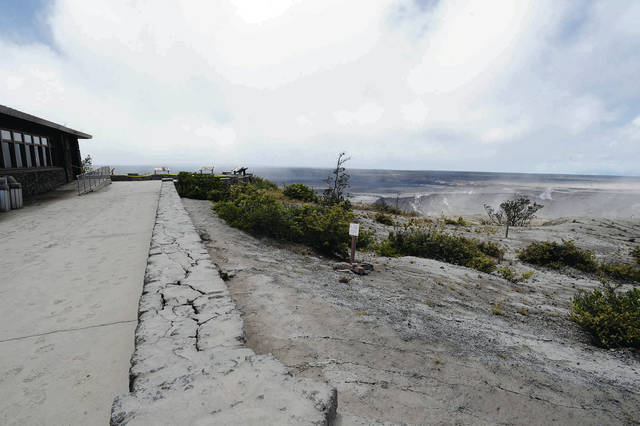
BRUCE ASATO / BASATO@STARADVERTISER.COM
Hawai‘i Volcanoes National Park and the summit of Kilauea Thursday. A layer of ash covered the overlook, and cracks could be seen in the rock wall.
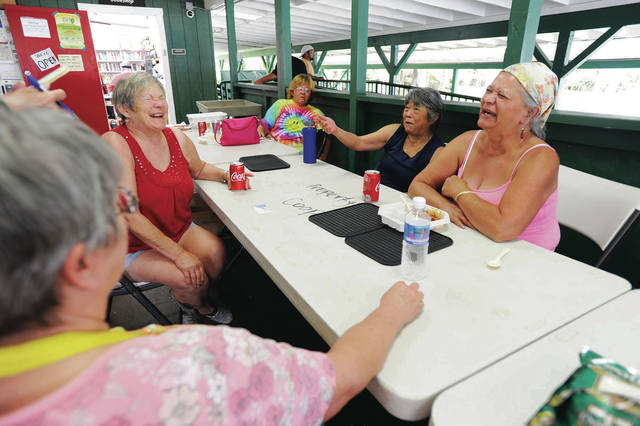
BRUCE ASATO / BASATO@STARADVERTISER.COM
Margo McClelland, left, Jan Whitesell, second from left, Kehau La‘a, right, and Betty Chin, second from right, are members of the Volcano Friends Feeding Friends program.
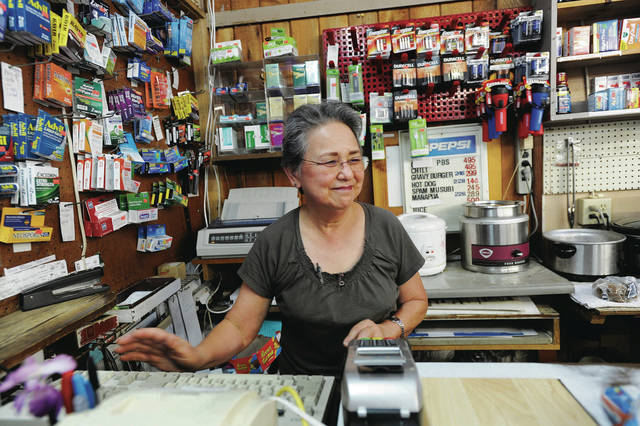
BRUCE ASATO / BASATO@STARADVERTISER.COM
Marie Onouye, co-owner of the Volcano Store, stood behind the counter Thursday welcoming customers to her store in Volcano village.
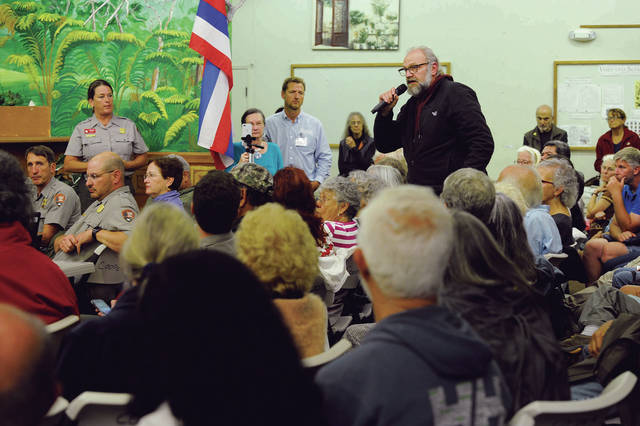
BRUCE ASATO / BASATO@STARADVERTISER.COM
Representatives from Hawai‘i Volcanoes National Park, U.S. Geological Survey and Hawaiian Volcano Observatory met with the community Thursday to discuss the ongoing seismic activity at the Cooper Center in Volcano village.
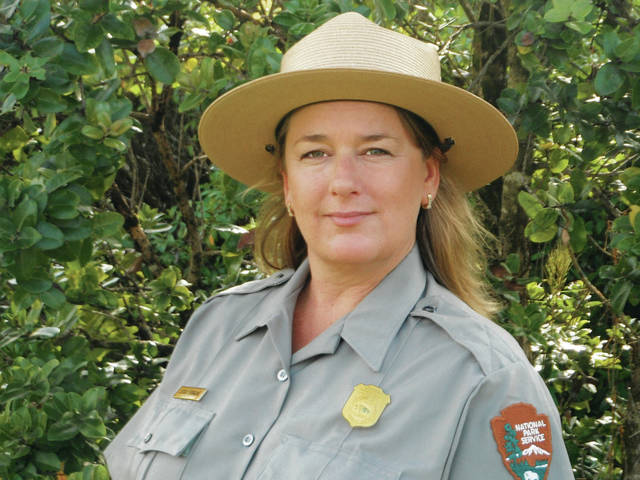
COURTESY PHOTO
“Volcano village is not just a community that’s outside the park; it’s more than that. It is our family, it’s where we live, it’s where our rangers raise their families. There’s a long historical connection between Hawai‘i Volcanoes National Park and our community,” said Jessica Ferracane, spokeswoman for Hawai‘i Volcanoes National Park.






VOLCANO, Hawaii >> The dynamic nature of Kilauea is what drew Betty Chin to Volcano village 35 years ago at the start of the Puu Oo eruption.
“I came here in 1983 so excited about the energy of the volcano. It’s what brought me here,” said Chin, 69. “I was compelled.”
Now that same potent energy is disturbing her sleep. Since the Kilauea summit began rumbling with renewed vigor and lava burst forth along the lower East Rift Zone in Puna in early May, Chin and the other Volcano residents have been experiencing strong earthquakes caused by near-daily explosions at Halemaumau Crater just 6 miles away.
“What was it, 4:20 or 4:23 this morning? It’s our shake-and-wake,” Chin said Thursday morning while sitting with a group of friends at the Cooper Center, a gathering spot for Volcano’s 2,500 residents.
In the two months since the latest Kilauea eruption began, Halemaumau has doubled in size as magma exits the summit magma reservoir at a high rate, causing the crater floor to drop and the ground around it to slump as its support erodes. With the continued deflation, the earthquakes have increased in number and intensity.
The U.S. Geological Survey’s Hawaiian Volcano Observatory reports that as of late June approximately 600 earthquakes were occurring daily at the summit region, compared with about 10 per day prior to the lead-up to the May 3 eruption. Scientists have figured that since mid-May the bigger explosive collapse events producing the large-magnitude quakes felt in Volcano village and nearby communities have been coming at somewhat regular intervals of 24 hours or so.
Don't miss out on what's happening!
Stay in touch with breaking news, as it happens, conveniently in your email inbox. It's FREE!
The ongoing instability of the Kilauea summit forced the closure of most of Hawai’i Volcanoes National Park on May 11, an earth- shaking event in itself for Volcano, whose commerce is dependent on the 2 million people who visit the park annually.
At the Volcano Store on Old Volcano Road, Marie Onouye said “it’s been very slow.” About 60 percent of its customers are tourists, she said, and business at the 40-year-old general store is down 60 percent since the eruption.
“Everyone’s in the same position,” said Onouye, 72, as she rang up a purchase that included a bright-red hot dog in a steamed bun. “It’s lasted so long, and they never closed the park before.”
The village’s relationship with the national park is about more than money, however. HVNP is one of Hawaii’s most significant cultural and recreational sites, and many Volcano residents feel a kinship with the rugged wilderness region and are regular visitors or volunteers.
The eclectic community includes retirees, farmers, federal USGS and HNVP employees and many others, all drawn to the cool climate, tranquil atmosphere and natural setting amid forest reserves of hapuu ferns and ohia lehua at the nearly 4,000-foot elevation. More than half the population is Caucasian, and the median age is 58, well above the county median age of 42, according to the U.S. Census Bureau.
“Volcano village is not just a community that’s outside the park; it’s more than that,” said HVNP spokeswoman Jessica Ferracane. “It is our family, it’s where we live, it’s where our rangers raise their families. There’s a long historical connection between Hawai’i Volcanoes National Park and our community.
“The people of Volcano have probably hiked more miles in this park than I have.”
It also is home to a lively art community.
“It’s the quiet and peaceful environment. You can get away and think, and be inspired by the beauty of this place,” said gallery manager Emily Catey Weiss of the Volcano Art Center.
ONE OF Volcano’s younger residents, Raysha Mae-Adrian, 19, sat on a bench at Cooper Center on Thursday while her 3-year-old daughter, Robyn, romped at the playground. Mae-Adrian lives across the street from the park in a 70-year-old house built by her great-grandfather.
She said she’s accustomed to earthquakes, vog and occasional sulfurous odors originating from Kilauea, but the recent activity has her “a little worried because it’s more intense and the earthquakes are a little more constant — but not too worried to where I’m going to move out of the area.”
“But it’s a little nerve-racking to think your house is going to fall down from one of these earthquakes.”
The eruption is affecting her life in other ways. Mae-Adrian said she is applying for a retail job in Hilo because work is scarce in her hometown.
“There’s not really any employment here. All the tourism is just gone, so people are being laid off because there’s not any business,” she said.
The drop-off in visitors to Hawaii island due to eruption-related fears has halved attendance at the Volcano Art Center’s Niaulani campus on Old Volcano Road, according to Weiss. Despite the downturn, the art center is continuing its education and outreach programs featuring many of the 250 local artists whose work is exhibited and sold there.
“We’re trying to keep those going strong. There were a lot of cancellations in the first few weeks, but it’s leveled off,” Weiss said.
Although the regular earthquakes have not damaged any buildings or artworks at the Niaulani Campus, which remains open daily, the nonprofit arts and education organization had to shut down its gallery at the 1877 Volcano House Hotel inside the park.
The art center has been using the historic property since 1974 under a lease with the National Park Service. The park gallery normally draws approximately 300,000 visitors a year, double the head count at the Niaulani campus, Weiss said.
To help those in the art community who may be dealing with eruption impacts, the Volcano Art Center is looking to boost their exposure by temporarily increasing exhibit space and other means.
“We’re doing some new things like online promotion and online auctions for selected artists to promote their work and put their names in front of our members because they can’t come in and see for themselves,” Weiss said.
AT A community meeting Thursday night in the Cooper Center, HVNP and USGS officials explained the processes causing the persistent seismic activity and the status of park facilities.
A contingent of USGS scientists said notwithstanding the episodic ground-shaking originating within and around the Kilauea caldera, the ash and sulphur dioxide output has been low, and a catastrophic collapse at the summit was “very unlikely.”
Many in the crowd of 100-plus residents seemed just as concerned about when they would be able to return to the park as about their safety at home. What they heard was not encouraging.
“Earthquakes continue to really degrade the water system, buildings and roads on a daily basis,” said HVNP Chief of Facilities Management Jon Christensen. Disruptions in water service have crippled the park’s firefighting capabilities, requiring that activities be minimized, he said.
Dramatic before-and-after photos showed cracks in various park locations widening from day to day. Christensen elicited gasps from the audience when reporting that just the day before, the ground opened behind the Kilauea Visitor Center. At Jaggar Museum overlooking Halemaumau Crater, walls and floors are cracked, and structural supports have separated from the building, which is slumping toward the scenic lookout, he said.
Across the crater, the parking lot at Halemaumau Overlook off Crater Rim Drive is just gone, having slid into the crater.
“We just don’t feel that it’s safe for you guys to be in the park at this time,” Christensen said.
“We don’t know how long it’s going to last. We don’t know if we’re at the beginning, the middle or the end of this, and every day that goes by there are more fractures formed, more subsidence taking place,” he said. “Nor do we know if it’s going to get more benign or more nasty.
“This is a period of great uncertainty, but we’re expecting one of these events tonight or tomorrow, and more down-dropping and more cracks.”
Responding to a question about whether any small area of the park could reopen sooner rather than later, Christensen said park officials had just started talking about the possibility of opening Mauna Loa Strip Road. But that would not happen without thoughtful deliberation.
“Once we opened, hundreds and maybe thousands of people would be going out there,” he said, affecting birds and other wildlife, parking, scheduled activities and other features.
Chief Park Ranger John Broward said his main concern is not being able to access emergency caches within the park or rescue visitors should they be suddenly cut off by earthquakes or other events.
EARLIER THURSDAY at the Cooper Center, Chin was finishing lunch with fellow residents Jan Whitesell, Margo McClelland and Kehau La’a. The women were there to prepare bratwurst with braised kale and cabbage, applesauce and corn chowder for their Volcano Friends Feeding Friends event, which serves up to 300 free dinners monthly.
While acknowledging the unsettling nature of the recent upheaval at the Kilauea summit, the group — like other Volcano residents interviewed by the Honolulu Star-Advertiser — were concerned but not overly so.
“We live in paradise, and if you live on a volcano, you kinda gotta expect some shaking and rolling and things like that,” said Whitesell, 68.
La’a, 59, was more wary.
“I live 7 straight miles to Puu Oo, and for years I saw her going, going, going,” she said. “I wasn’t that worried until I remembered that Puu Oo just popped out of nowhere 7 miles away from me.
“I’m of the mind that it could pop up anywhere, so we have that fear.”
When asked whether any of the group were thinking about moving away, without hesitation they replied, “Never.”
“This community is so stimulating and the residents are so amazing,” Whitesell said.
“Our neighborhood is surrounded by USGS and national park employees, so as soon as we see all their vehicles leaving, we’re right behind them,” joked McClelland, 64.
Any worries aside, “what we miss is our park,” Chin said. “The park is our backyard.”
Hawaiian Volcano Observatory FAQs about Kilauea summit earthquakes: 808ne.ws/2tVnafW Opens in a new tab



